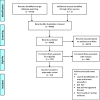Health promotion interventions post-stroke for improving self-management: A systematic review
- PMID: 33996032
- PMCID: PMC8082985
- DOI: 10.1177/20480040211004416
Health promotion interventions post-stroke for improving self-management: A systematic review
Abstract
Background: It is well-documented that women tend to be worse off post-stroke. They are often frailer, have less independence, lower functionality, increased rates of depression, and overall a lower quality of life. People who have had strokes benefit from rehabilitative support to increase their independence and reduce the risk of stroke reoccurrence. Despite the gender differences in the effects of stroke, interventions explicitly aimed at helping women have not been identified.
Purpose: This systematic review aimed to summarize the effectiveness of the health promoting behavioural interventions for reducing risk factors and improved self-management in women post-stroke, compared to usual care.
Method: Seven databases, Medline (Ovid), CINAHL, PsychInfo, Embase, PubMed, Scopus, and Google Scholar, were reviewed for randomized controlled trials covering post-stroke interventions. The following keywords were used: health promotion, secondary prevention, woman, women, female, sex difference, gender difference, after stroke, and post-stroke.
Results: Ten randomised controlled trials were found. These demonstrated common successful approaches for rehabilitation, but none specifically described health promotion strategies for women. Core components of successful programs appeared to be a structured approach, tailored to clientele and formalised support systems through their carer, family networks, or community engagement. Comprehensive reminder systems were successful for stroke risk reduction.
Conclusion: Women are disproportionately affected by stroke and are often in the frail category. Tailored structured health promotion programs with family and caregiver support combined with a comprehensive reminder system would appear to enable women post-stroke.
Keywords: After-stroke; cardiology; female; health promotion; secondary prevention; treatment.
© The Author(s) 2021.
Conflict of interest statement
Declaration of conflicting interests: The author(s) declared no potential conflicts of interest with respect to the research, authorship, and/or publication of this article.
Figures
Similar articles
-
Promoting and supporting self-management for adults living in the community with physical chronic illness: A systematic review of the effectiveness and meaningfulness of the patient-practitioner encounter.JBI Libr Syst Rev. 2009;7(13):492-582. doi: 10.11124/01938924-200907130-00001. JBI Libr Syst Rev. 2009. PMID: 27819974
-
Effectiveness of interventions that assist caregivers to support people with dementia living in the community: a systematic review.Int J Evid Based Healthc. 2008 Jun;6(2):137-72. doi: 10.1111/j.1744-1609.2008.00090.x. Int J Evid Based Healthc. 2008. PMID: 21631819
-
Effectiveness of interventions that assist caregivers to support people with dementia living in the community: a systematic review.JBI Libr Syst Rev. 2008;6(13):484-544. doi: 10.11124/01938924-200806130-00001. JBI Libr Syst Rev. 2008. PMID: 27820474
-
Psychological interventions to improve self-management of type 1 and type 2 diabetes: a systematic review.Health Technol Assess. 2020 Jun;24(28):1-232. doi: 10.3310/hta24280. Health Technol Assess. 2020. PMID: 32568666 Free PMC article.
-
Interventions for adults with a history of complex traumatic events: the INCiTE mixed-methods systematic review.Health Technol Assess. 2020 Sep;24(43):1-312. doi: 10.3310/hta24430. Health Technol Assess. 2020. PMID: 32924926 Free PMC article.
Cited by
-
Perceived social support, self-management, perceived stress, and post-traumatic growth in older patients following stroke: Chain mediation analysis.Medicine (Baltimore). 2024 Jul 19;103(29):e38836. doi: 10.1097/MD.0000000000038836. Medicine (Baltimore). 2024. PMID: 39029078 Free PMC article.
References
-
- World Health Organization. The top ten causes of death, www.who.int/news-room/fact-sheets/detail/the-top-10-causes-of-death (2019, accessed 7 March 2020).
-
- Stroke Foundation NZ. Reducing your risk of stroke, www.stroke.org.nz/reducing-stroke-risk (2019, accessed 7 March 2020).
-
- Slark J, Bentley P, Majeed A, et al.. Awareness of stroke symptomatology and cardiovascular risk factors amongst stroke survivors. J Stroke Cerebrovasc 2012; 21: 358–362. - PubMed
-
- Nicholson SL, Donaghy M, Johnston M, et al.. A qualitative theory guided analysis of stroke survivors’ perceived barriers and facilitators to physical activity. Disabil Rehabil 2014; 36: 1857–1868. - PubMed
-
- Poltawski L, Boddy K, Forster A, et al.. Motivators for uptake and maintenance of exercise: perceptions of long-term stroke survivors and implications for design of exercise programmes. Disabil Rehabil 2015; 37: 795–801. - PubMed
Publication types
LinkOut - more resources
Full Text Sources


